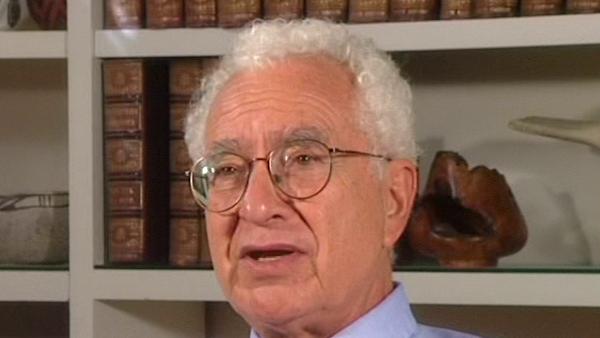NEXT STORY

Asymptotic freedom in field theory; Gross and Wilczek
RELATED STORIES

NEXT STORY

Asymptotic freedom in field theory; Gross and Wilczek
RELATED STORIES


|
Views | Duration | |
|---|---|---|---|
| 131. Feynman's partons | 1459 | 03:12 | |
| 132. Quarks as asymptotic states. Missed opportunities | 580 | 01:35 | |
| 133. A year at CERN. Parastatistics and color | 516 | 02:57 | |
| 134. Parastatistics and color: using the correct data | 460 | 00:52 | |
| 135. Calculating pi-zero into two gamma. Giving a talk in Munich | 476 | 02:59 | |
| 136. My 'business trip' honeymoon in 1992 | 501 | 03:07 | |
| 137. Reading from Quarks, color and QCD | 477 | 02:37 | |
| 138. The ninth axial vector current and the corresponding pseudo-scalar... | 434 | 03:03 | |
| 139. Asymptotic freedom in field theory; Gross and Wilczek | 779 | 02:03 | |
| 140. The color picture with confined color | 444 | 01:06 |


In the talk that I gave in Chicago with David Gross in the chair, I mentioned both the Yang-Mills theory—essentially quantum chromodynamics—and the string version of it, a possible string version of it, we didn't know exactly what that would look like. But I didn't emphasize it very much and in the written version we just sort of glossed over it, because we were worried about these three points. But later on Fritzsch and Leutwyler and I took up this matter in a… a letter that we wrote in 1973, from Aspen. We were all in Aspen, Colorado together, and there we took up what I referred to out of… or… out of its proper place a moment ago, which was the problem of the ninth axial vector current and the corresponding pseudo-scalar boson. And this–since it's a bit complicated–let me read again from what I wrote in that paper:
We discussed in the limit of vanishing quark masses, conservation of the flavor singlet axial vector current which threatens to yield four light pseudo-scalar mesons instead of three in the case of SU(2) of flavor, and nine instead of eight for SU(3) of flavor, contrary to fact. That was an old preoccupation of mine. Does the divergence of the axial vector current, the ninth axial vector current or the fourth axial vector current, actually go to zero as the masses go to zero? Theory seemed to have that difficulty. But there's an anomaly in the theory proportional to a term bilinear in the gluon fields. But the anomaly term itself is the divergence of another current, so if we add that current to the axial vector current, we still have the divergence of a current going to zero as mass going to zero, which seems to give the difficulty back in another form. But there were two more ‘buts’, fortunately an even number that we didn't cover in our letter. The charge integral J naught five b cubed x does appear to be gauge invariant and the time derivative of the total charge seems to go to zero as the masses go to zero, and that's apparently gauge invariant. But, as was shown by Polyakov and company and by 't Hooft in connection with instantons, this charge is only locally but not globally gauge invariant. So in fact, there's no problem of a fourth or a ninth light pseudo-scalar boson.
New York-born physicist Murray Gell-Mann (1929-2019) was known for his creation of the eightfold way, an ordering system for subatomic particles, comparable to the periodic table. His discovery of the omega-minus particle filled a gap in the system, brought the theory wide acceptance and led to Gell-Mann's winning the Nobel Prize in Physics in 1969.
Title: The ninth axial vector current and the corresponding pseudo-scalar boson
Listeners: Geoffrey West
Geoffrey West is a Staff Member, Fellow, and Program Manager for High Energy Physics at Los Alamos National Laboratory. He is also a member of The Santa Fe Institute. He is a native of England and was educated at Cambridge University (B.A. 1961). He received his Ph.D. from Stanford University in 1966 followed by post-doctoral appointments at Cornell and Harvard Universities. He returned to Stanford as a faculty member in 1970. He left to build and lead the Theoretical High Energy Physics Group at Los Alamos. He has numerous scientific publications including the editing of three books. His primary interest has been in fundamental questions in Physics, especially those concerning the elementary particles and their interactions. His long-term fascination in general scaling phenomena grew out of his work on scaling in quantum chromodynamics and the unification of all forces of nature. In 1996 this evolved into the highly productive collaboration with James Brown and Brian Enquist on the origin of allometric scaling laws in biology and the development of realistic quantitative models that analyse the influence of size on the structural and functional design of organisms.
Tags: Chicago, Aspen, Colorado, David Gross, Harald Fritzsch, Heinrich Leutwyler, Alexander Markovich Polyakov, Gerard 't Hooft
Duration: 3 minutes, 4 seconds
Date story recorded: October 1997
Date story went live: 29 September 2010